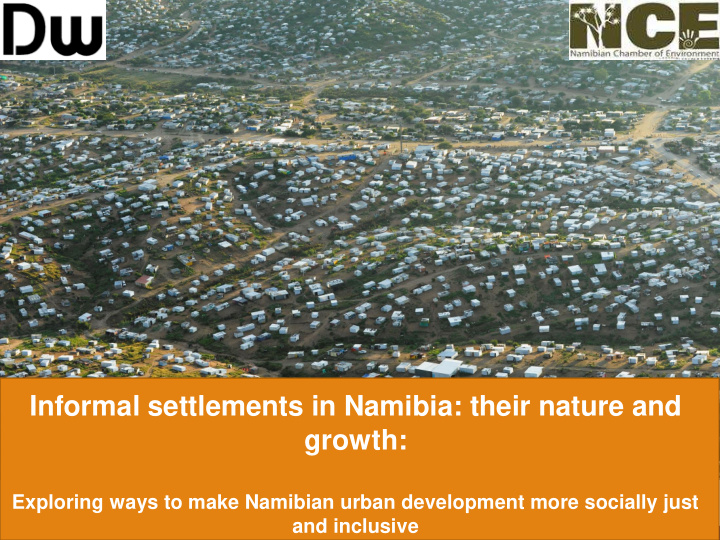



Informal settlements in Namibia: their nature and growth: Exploring ways to make Namibian urban development more socially just and inclusive An Authorised Financial Services Provider Strictly Private and Confidential
Objectives of the study and book To provide information about informal settlements, in particular their: Growth Physical conditions Social and economic dimensions To describe approaches to urban planning used by local authorities to address informal growth and development.
Content Informal settlement growth Characteristics of informal settlements Approaches of local authorities to informal settlement growth and development Recommendations
Namibia is changing rapidly from a rural to an urban society 2001-2011: rural population dropped by 20,000 / urban population increased by 300,000 people This is a regional trend
Informal settlements are developing everywhere
Informal settlements are the main driver of urban growth Formal and informal housing increasing rapidly, but informal growth is much faster rate
Informal settlements are expected to grow About 12,000 new informal homes built each year
In 2025, there will be more shacks than brick houses In 2030, 79% of Namibian homes will be in urban areas In 2030, 46% of Namibian families will be in shacks
Expansion of informal settlements, e.g. Windhoek Rapid informal settlement growth most visible by rapid geographic expansion Shacks in 2012 Shacks in 2016 > 3 500 shacks-like homes per year
Expansion of informal settlements, e.g. Gobabis Shacks in 2012 Shacks in 2016 >350 shack-like homes per year
Content Informal settlement growth Characteristics of informal settlements Approaches of local authorities to address informal settlement growth Recommendations
Access to infrastructure and services, e.g. sanitation on In 2011, almost 380,000 urban residents had no access to toilet facilities
And the same for: o Fuel for cooking, lighting and heating o Water o Waste removal o Sewage treatment o Roads o Social services
Informal settlement structures Most informal settlements are unstructured with no or limited planning Densification hampers upgrading and service provision Cannot be proclaimed without physically rearranging the whole settlement
Informal settlement structures Upgrading is expensive, socially costly and lengthy Provision of infrastructure and services is difficult Create huge headache and legacy for future governments and society
Tenure security Informal settlements are not proclaimed (legalised) and so residents cannot have secure land tenure Permanent structures often prohibited on properties without formal tenure Non-permanent housing materials often not suitable for Namibia’s climate.
Implications of a lack of st structure and ten enure 1. Limited options to legalise settlement No planned structure 2. No secure tenure 3. Limited provision of services and infrastructure 4. Limited overall development options for the settlement 5. Development requires shifting of people, which incurs significant financial, social and political costs 1. Access to credit limited No tenure 2. Risks of eviction 3. No investment or wealth generation options
Who are the informal settlers?
1. Most are immigrants from rural areas or other towns 2. Most are young 3. Most are looking for a better life: • Jobs and incomes • Enterprises and income • Education and other services 4. Most are energetic, ambitious and eager to build: ◦ homes ◦ enterprises and ◦ a decent future
What does Namibia want to do with this energy, ambition and eagerness to build a future?
Content Informal settlement growth Characteristics of informal settlements Approaches of local authorities to address informal settlement growth Recommendations
Scope and objectives Objective: how do local authorities deal with rapid informal settlement growth? Towns: Gobabis, Outapi, Oshakati, Windhoek and Otjiwarongo
Major challenges 1. Long waiting list: residents that need land for housing 2. Budget cuts: reduced funding available for servicing land 3. Township establishment: slows down the provision of urban land 4. Lack of technical and human resources for implementation of land development projects
Interventions of local authorities All towns: considerable resources invested in servicing, upgrading, provision of land For example: Gobabis: Successful upgrading of Freedom Square informal settlement; provision of low cost land on large scale in Kaanan; Windhoek: upgrading of many existing informal settlements; Oshakati: formalizing informal settlements and provision of serviced erven at large scale; Outapi & Otjiwarongo: Provision of minimally and non serviced erven on large scale; Provision of minimally serviced erven at large scale identified as especially effective to control informal settlement growth
Example: Otjiwarongo Structured informal settlements with different levels of services; Large percentage of housing with permanent building materials Similar approaches observed in Outapi, Gobabis, Oshakati
Key components of the approach Informal settlements planned and surveyed BEFORE people begin settling – pre-emptive measure to avoid disorganized growth; Settlement proclaimed in parallel or later; Services provided incrementally; Residents build homes at their own pace; Transforms informal growth into formal growth of settlements Effective approach with considerable potential for other towns in Namibia;
Financial sustainability Required for an organized settlement: Town planning & land surveying only 3-5% of the costs of a fully serviced erf; N$3,000 – N$5,000 for fully serviced erf of N$ 100,000 Minimal services: o Water reticulation system and communal water points: approx. N$ 3,500/erf o Levelling of roads: approx. N$ 3,000/erf o Use of pit latrines as a temporary sanitary solution o Total approx. N$10,000/erf This is affordable for a large majority of low income residents Costs can be recovered by sale of erven Makes approach financially sustainable; can be scaled up through investments by private sector
Content Informal settlement growth Characteristics of informal settlements Approaches of local authorities to address informal settlement growth Recommendations
Recommendations Recommendation 1: Focus on the provision of land not housing Recommendation 2: Gain control over informal settlement expansion Recommendation 3: Support innovative, proactive and pragmatic approaches of local authorities Recommendation 4 : Accelerate the provision of tenure in structured or upgraded informal settlements
Recommendations Recommendation 5: Attract private sector investment for the provision of low cost land Recommendation 6: Attract international donor funding and CSR support for settlement upgrading projects Recommendation 7: Turn rapid urbanisation and the creation of new townships into an economic opportunity for Namibia
Recommend
More recommend